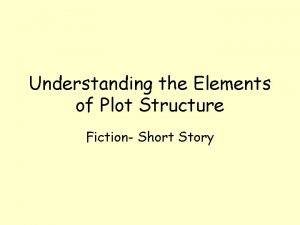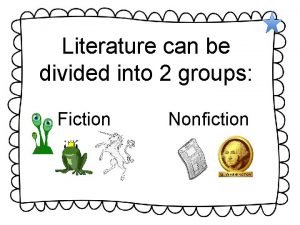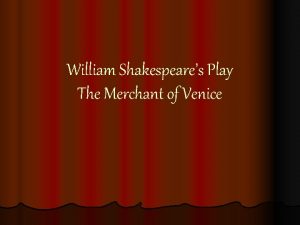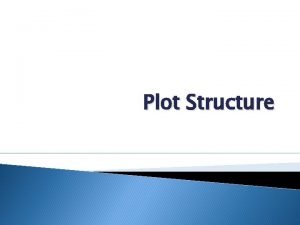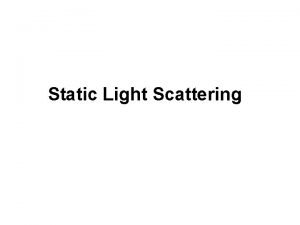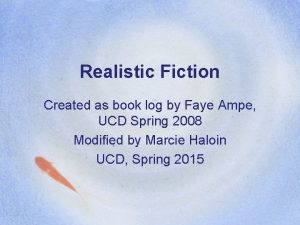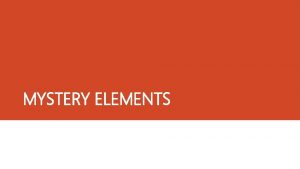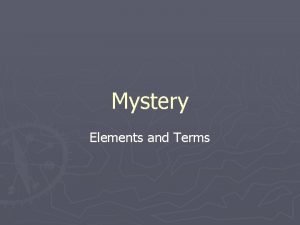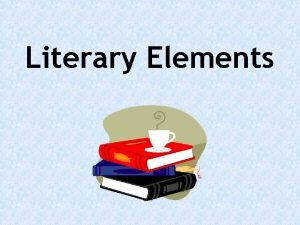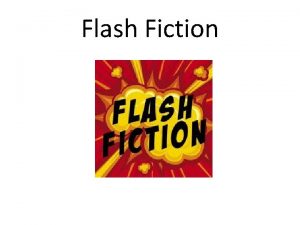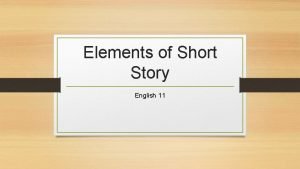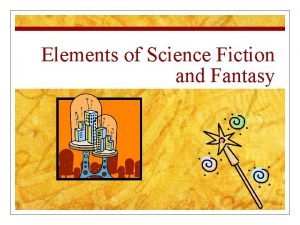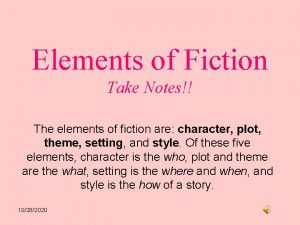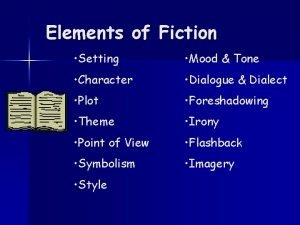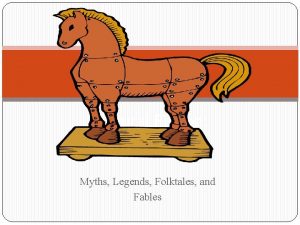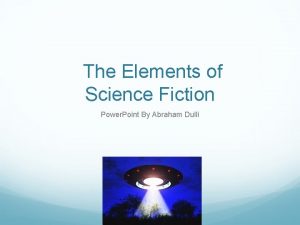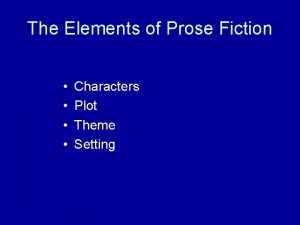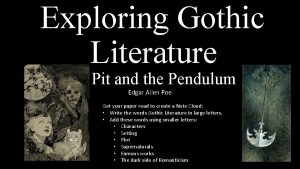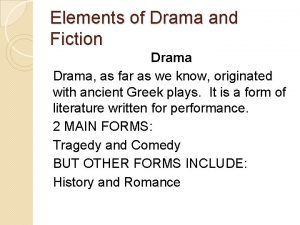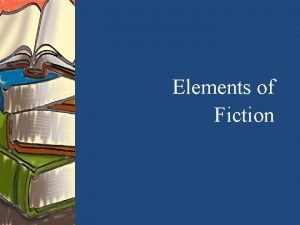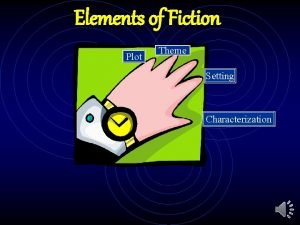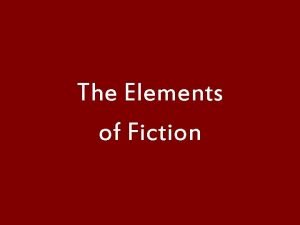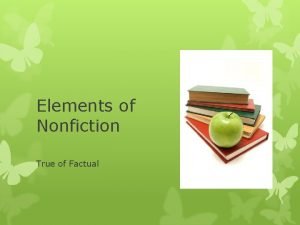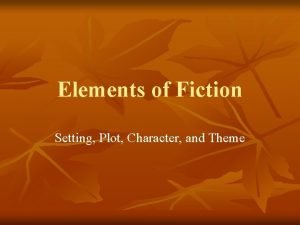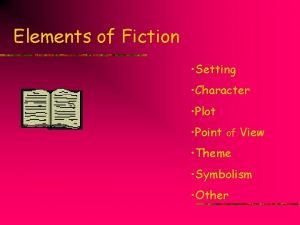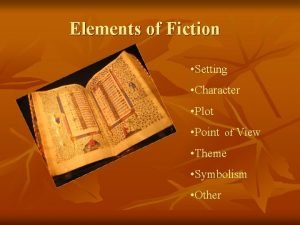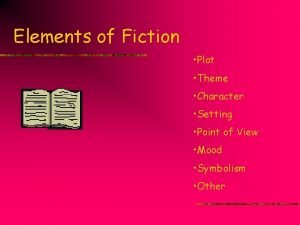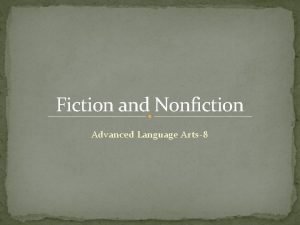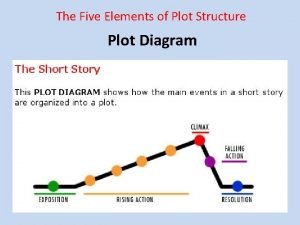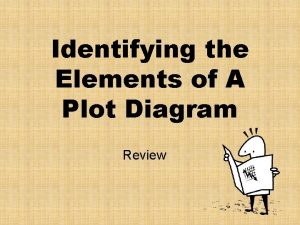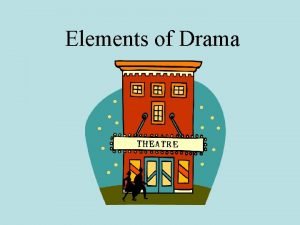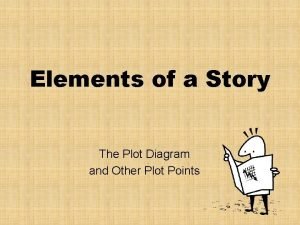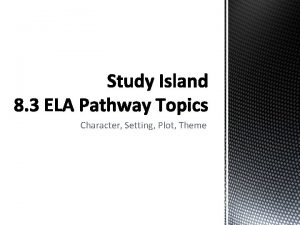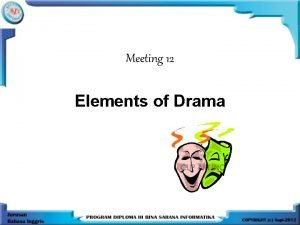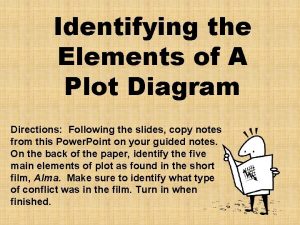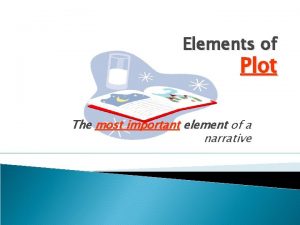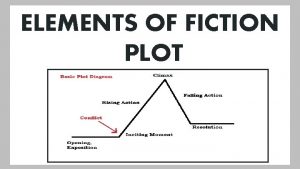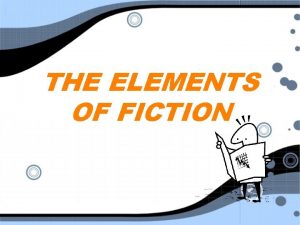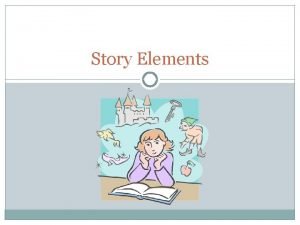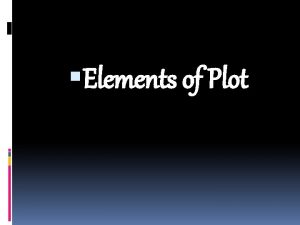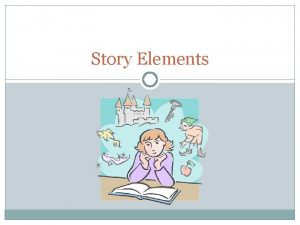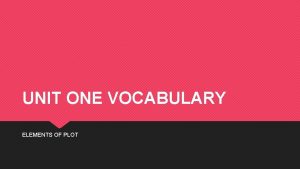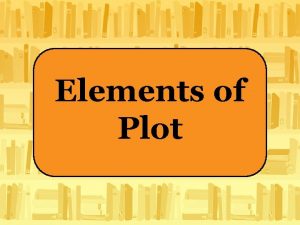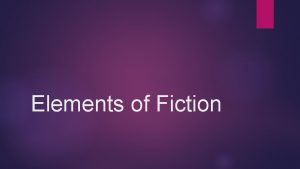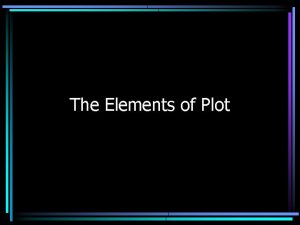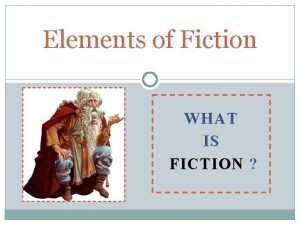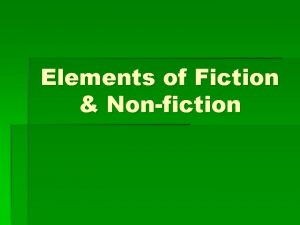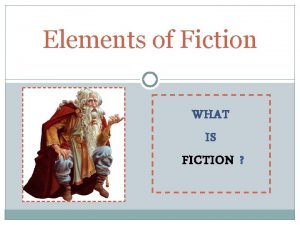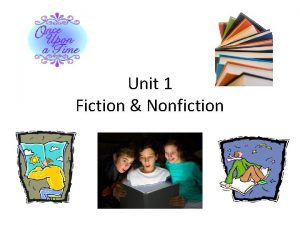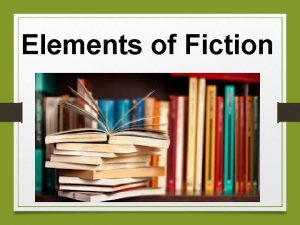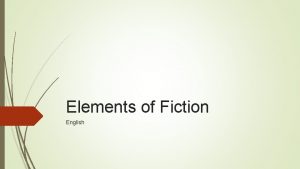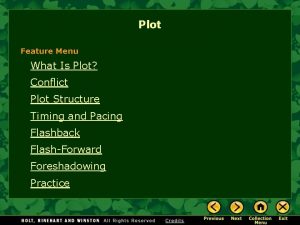ELEMENTS OF FICTION ELEMENTS OF FICTION 1 PLOT






























![CHARACTERIZATION • Methods of Characterization [“Show and Tell”; or Telling versus Showing], • 1. CHARACTERIZATION • Methods of Characterization [“Show and Tell”; or Telling versus Showing], • 1.](https://slidetodoc.com/presentation_image_h2/5b17d3686049fd81e9f0a7d8c9e8b4e0/image-31.jpg)






















- Slides: 53

ELEMENTS OF FICTION

ELEMENTS OF FICTION 1. PLOT 2. SETTING 3. CHARACTER 4. NARRATION/ POINT OF VIEW 5. SYMBOL AND FIGURATIVE LANGUAGE 6. THEME

PLOT WHAT HAPPENS IN THE STORY? WHAT IS THE DESIGN (STRUCTURE) ” – TIME “LINE” – OF THE NARRATIVE? THE PLOT IS THE SERIES OF EVENTS AND ACTIONS THAT OCCUR IN A STORY. THE STRUCTURE OF THE PLOT IS THE METHOD OR SEQUENCE IN WHICH INCIDENTS IN A NARRATIVE ARE ORGANIZED/PRESENTED TO THE AUDIENCE/READERS.

• *Action = the events that have occurred, without being “tampered with” • *Sequence = order of events PLOT/ACTION/SEQUENCE/ SUBPLOT • *Plot = the way author sequences and paces events so as to shape our response and interpretation

PLOT – FREYTAG’S PYRAMID Plot is the literary element that describes the structure of a story. It shows arrangement of events and actions within a story.

*PLOT COMPONENTS *Climax: the turning point, the most intense moment—either mentally or in action *Rising Action: the series of conflicts and crisis in the story that lead to the climax *Falling Action: all of the action which follows the climax AKA Dénouement *Exposition: the start of the story, introduces character and setting *Resolution: the conclusion, the tying together of all of the threads

• *Sub-plots: A story within a story. . . • Sub-plots are the little things going on in the background that often make the main plot more interesting by giving the reader more to think about. These little events are especially effective when they tie in seamlessly with the main plot.

• *Flashback: a scene inserted into a film, novel, story, or play to show events that occurred at an earlier time – this technique is used to complement the events in the “present” of the story. • *Foreshadowing: a literary device where the outcome or conflict is hinted at – by such elements as speeches or actions of characters or by symbols in the story.

• Conflict: Some plot elements are optional. Conflict is not. Without conflict, there is no purpose. • Characters want something they do not have, or they are looking for ways to change their current reality, or they must overcome challenges of some kind, however great or minute. Were someone to write a story without conflict and the product would be a character sketch or a character study.

CONFLICT

PLOT: CONFLICT *Conflict is the dramatic struggle between two forces in a story. Without conflict, there is no plot.

*PLOT: TYPES OF CONFLICT *Character vs Character *Character vs Nature *Character vs Society *Character vs Self

PLOT: CHARACTER VS. CHARACTER CONFLICT This type of conflict finds the main character in conflict with another character, human or not human. “The new one is the most beautiful of all; he is so young and pretty. ” And the old swans bowed their heads before him. Then he felt quite ashamed, and his head under his wing; for he did not know what to do, he was so happy, and yet not at all proud. He had been persecuted and despised for his ugliness, and now he heard them say he was the most beautiful of all the birds. The Ugly Duckling by Hans Christian Anderson

PLOT: CHARACTER VS. NATURE CONFLICT This type of conflict finds the main character in conflict with the forces of nature, which serve as the antagonist. It´s a Truffula Seed. It´s the last one of all! You´re in charge of the last of the Truffula Seeds. And Truffula Trees are what everyone needs. Plant a new Truffula. Treat it with care. Give it clean water. And feed it fresh air. Grow a forest. Protect it from axes that hack. Then the Lorax and all of his friends may come back. The Lorax by Dr. Seuss

PLOT: CHARACTER VS. SOCIETY CONFLICT This type of conflict has the main character in conflict with a larger group: a community, society, culture, etc. “I’m tired of living in a hole, ” said Jenny. “Let’s fight for freedom!” cried Bouncer. “We’ll be soldiers! Rough-riding Rowdies! I’ll be the general and commander-in-chief!” The Island of the Skog by Steven Kellogg

PLOT: CHARACTER VS. SELF CONFLICT In this type of conflict, the main character experiences some kind of inner conflict. Finally, Sam’s father said, “Go to bed now. But before you go to sleep, Sam, tell yourself the difference between REAL and MOONSHINE. ” Sam, Bangs & Moonshine by Evaline Ness

SETTING

*SETTING IS BOTH TIME AND PLACE

WHERE (PLACE) • Where = the physical environment where the story takes place ( the description of this environment may suggest its importance to other aspects of the fiction such as theme

WHEN (TIME) • When = time includes all of its dimensions. What was going on at the time? What, if any, importance has the period and/or time -span of events with regard to themes, motifs, characterizations, atmosphere, tone, etc. ? • 1. What is the period (century, decade, year) during which the action occurs? • 2. Over how many hours, days, weeks, months, years, decades, etc. does the action take place? • 3. The effects of the setting may include a particular atmosphere, insight to the characters and/or their motivations, and a key connection to or reflection of other aspects of the story

• *Atmosphere (mood) – the dominant emotion / feeling that pervades a story • A. Every story has some kind of atmosphere, but in some, it may be the most important feature, or, at least, a key to the main points of the story • B. Atmosphere is created by descriptive details, dialogue, narrative language, and such *SETTING OFTEN CONTRIBUTES TO ATMOSPHERE OR MOOD

CHARACTER

• “Fiction” is defined as any imaginative re-creation of life in prose narrative form. All fiction is a falsehood of sorts because it relates events that never actually happened to people (characters) who never existed, at least not in the manner portrayed in stories. However, fiction writers aim at creating “legitimate untruths, ” since they seek to demonstrate meaningful insights into the human condition. Therefore, fiction is “untrue” in absolute sense, but true in the universal sense.

CHARACTER / CHARACTERIZATION • Character - is the mental, emotional, and social qualities to distinguish one entity from another (people, animals, spirits, automatons, pieces of furniture, and other animated objects). • Character development - is the change that a character undergoes from the beginning of a story to the end. The importance of a character to the story determines how fully the character is developed. • Characterization - process by which fictional characters are presented/developed

EVIDENCE TO CONSIDER IN ANALYZING A CHARACTER • Name • Physical appearance • Objects and places associated with them • Actions • Thoughts and speech, including – Content (what) Timing (when) Phrasing (how) • Other character's thoughts about character • Other character’s comments about character • Narrator Considering these questions will help you determine what type of character you’ve got.

TYPES OF CHARACTERS • Flat: a one-dimensional character, typically not central to the story • Round: a complex, fully - developed character, usually prone to change • Static: these can be either round or flat characters, but they do not change during the story. Folktales, fairytales, and other types use static and flat characters whose actions are predictable, so the reader is free to concentrate on the action and them as each moves toward an often times universal discovery

TYPES OF CHARACTERS CONTINUED • Dynamic – a developing character, usually at the center of the actions, who changes or grows to a new awareness of life • Stock / Stereotype – “borrowed” personages or archetype / a character so little individualized as to show only qualities of an occupation, or national ethnic, or other group which s/he belongs

FUNCTIONS OF CHARACTER PROTAGONIST V. ANTAGONIST Protagonist – the principle figure in the story Antagonist – the character with whom the protagonist is engaged in a struggle HERO V. VILLAIN Hero – the good guy Antihero – possesses traits that make him/her the opposite of the traditional hero Villain – the bad guy

FUNCTIONS OF CHARACTERS • Confidant – the character in whom another character (usually the protagonist) confides in • Foil – a secondary character serving as a backdrop (mirror) for a more important character. Typically, the foil is rather ordinary and static so that the unusual qualities of the primary character will be more striking in contrast. Can often be both the confidant and foil

UNCOMMON TYPES OF CHARACTERS • Anthropomorphic characterization – is the characterization of animals, inanimate objects, or natural phenomena as people. Skilled authors can use this to create fantasy even from stuffed toys • Animal characters – personified create particular effects, especially when the animal characters contain connotative metaphoric connects to human traits, i. e. Fox = sly, weasel = duplicity, swan = elegance
![CHARACTERIZATION Methods of Characterization Show and Tell or Telling versus Showing 1 CHARACTERIZATION • Methods of Characterization [“Show and Tell”; or Telling versus Showing], • 1.](https://slidetodoc.com/presentation_image_h2/5b17d3686049fd81e9f0a7d8c9e8b4e0/image-31.jpg)
CHARACTERIZATION • Methods of Characterization [“Show and Tell”; or Telling versus Showing], • 1. Expository/Direct Presentation: described and/or “explained” by the narrator • 2. Dramatic/Indirect Presentation: actions “show” the kind of person the character is – a. His/Her own actions, behavior, speech, and recorded thoughts and/or – b. Qualities are apparent by what other characters say about him/her

NARRATION AND POINT OF VIEW WHO IS TELLING THE STORY?

NARRATIVE POINT OF VIEW • Narrative Point of View is the perspective from which the events in the story are observed and recounted. To determine the point of view, identify who is telling the story, that is, the viewer through whose eyes the readers see the action (the narrator). • Consider these aspects: • Pronoun p-o-v: First (I, We)/Second (You)/Third Person narrator (He, She, It, They] • Narrator’s degree of Omniscience [Full, Limited, Partial, None]* • Narrator’s degree of Objectivity [Complete, None, Some (Editorial? ), Ironic]* • Narrator’s “Un/Reliability”

• The Third Person (therefore, apparently Objective) Totally Omniscient (fly-on-the-wall) Narrator is the classic narrative point of view through which a disembodied narrative voice (not that of a participant in the events) knows everything (omniscient) recounts the events, introduces the characters, reports dialogue and thoughts, and all details. • Nota Bene: Whether the voice of an unidentified, anonymous speaker or that of an observer/character in the story, the narrator is never the author [never], not even if the character has the same name as the author. As with “real” life, one should always “consider the source” of a report and/or evaluation concerning events and/or people. • Therefore, “know” who is telling the story, measure the omniscient details (if any), note how objectively the report (story) is related, and determine how reliable the person/voice (narrator) may be. For example, does s/he have anything to gain from misrepresenting the “facts”?

TYPES OF NARRATIVE VOICE: • A. Omniscient - a story told in the third person; the narrator's knowledge, control, and prerogatives are unlimited, allowing “authorial” subjectivity. • B. Limited Omniscient - a story told in the third person in which the narrative voice is associated with a major or minor character who is not able to “see/know” all, may only be able to relate thoughts of one or some characters but not others, may not know what happened “off stage” or in the past.

TYPES OF NARRATIVE VOICE: • C. First Person - the story is told from the first person "I” personal point-of-view, usually that of the main character. – Interior Monologue – first-person, train of thought “overheard” by the reader (NOT spoken out loud as is a monologue), or sometimes “overheard” and reported by an omniscient narrator; other times it occurs as stream of consciousness (“The Jilting of Granny Weatherall”). – Subjective Narration - first person, narrator seems unreliable, tries to get readers to share his/her side or to assume values or views not usually presumed by the reader. – Detached Autobiography - first person, reliable narrator that guides the reader. Narrator is main character, often reflecting on a past "self” – sometimes an adult recounting an event from childhood. When it is the latter, it is important to notice “how” the adult voice affects the child’s story. – Memoir or Observer Narration - first person, narrator is observer rather than main participant; narrator can be confidant(e), eyewitness or "chorus" (provides offstage or background information). This narrator can be reliable or unreliable.

TYPES OF NARRATIVE VOICE: • D. Objective or Dramatic - the opposite of the omniscient; displays an objectivity; compared to a roving camera with sound. Very little of the past or the future is given; the story is set in the present. It has the most speed and the most action; it relies heavily on external action and dialogue, and it offers no opportunities for interpretation by the narrator. • E. Framed Narrative – some narratives, particularly collections of narratives, involve a frame narrative that explains the genesis of, and/or gives a perspective on, the main narrative or narratives that follow, e. g. , Chaucer’s Canterbury Tales; Mary Wollstonecraft Shelley’s Frankenstein; and Joseph Conrad’s Heart of Darkness. Some stories have multiple narrative frames that draw the reader away from the initial, outer setting (and the “reality” of the story) through a narrative maze to the core events that are far/deeply removed from the first narrative encounter, e. g. , Henry James’s short story “The Turn of the Screw. ”

• Style refers to the qualities that distinguish the works of one author from another’s, including: • Diction: word choice: formal/informal • Sentence Structure (simple or complex) • Syntax: sentence patterns of language - grammatical and ungrammatical arrangements of words • Language: abstract or concrete • Dialogue: can be either more dialogue than description, or STYLE

STYLE • Imagery: sensory details such as similes, metaphors, onomatopoeia in a work includes: – Visual: imagery of sight – Aural: imagery of sound (e. g. , soft hiss of skis) – Olfactory: imagery of smell (e. g. , the smell of stale beer) – Tactile: imagery of touch (e. g. , the feel of bare feet on a hot sidewalk) – Gustatory: imagery of taste (e. g. , the tart, dry taste of starchy, green bananas)

• While related to atmosphere, tone is distinct from it. Tone is the narrator’s attitude toward his subject and audience • Narrator’s tone may show, for example, admiration for the subject or a character • Or the narrative tone can suggest pity or hostility; on the other hand, the narrator may be condescending or “folksy” with the audience • Sometimes the narrative tone is ironic • The narrative tone may be demonstrated by direct comment, by characterization, or by choice of words, symbols, or other literary devices. TONE

SYMBOL AND FIGURATIVE LANGUAGE

SYMBOLS • Symbols : symbols are concrete objects/images that stand for abstract subjects. The objects and images have meanings of their own but may be ascribed subjective connotations such as heart = love, skull & crossbones = poison, color green = envy; light bulb = idea, seasons = times in a lifespan. • Symbols may be either of two types: • 1. Established (General): the meaning of an established symbol is derived from outside the context of the story, from “received association, ” – i. e. symbolism is agreed upon “universally” (artificially) by culture, religion, tribe, kinship, etc. For example, a journey = life; water = rebirth/new beginning; lion = courage • 2. Private (Personal): definable only within the context of the story in which it appears. – For example, early in T. S. Eliot’s long poem “The Waste Land” the narrative voice issues, “Come in under the shadow of the rock. ” In Eliot’s poem, the red rock is symbolic of the spiritual shelter of the Anglican Church, although this is not a “received” symbol traditional to any particular culture.

HOW DO I KNOW A SYMBOL IS A SYMBOL? • 1. The story itself must furnish a clue that a detail is to be taken symbolically - symbols nearly always signal their existence by emphasis, repetition, or position. • 2. The meaning of a literary symbol must be established and supported by the entire context of the story. A symbol has its meaning inside not outside a story. • 3. To be considered a symbol, an item must suggest a meaning different in kind from its literal meaning. • 4. A symbol has a cluster of meanings.

ALLEGORY • Allegory a literary work in which the symbols, characters, and events come to represent, in a somewhat point –t point fashion, a different metaphysical, political, or social situation. • In Western culture, allegories have often been used for instructive purposes around Christian themes; for example, John Bunan’s Pilgrim’s Progress in which the main character “Christian” goes on a journey in which he encounters such characters as Mr. Worldly Wise, Vanity Fair, and the Slough of Despond –all depicting the struggles of a Christian trying to stay pure.

FIGURES OF SPEECH/FIGURATIVE LANGUAGE • Tropes – supplement or replace literal meaning, and create imaginative connections between our ideas and our senses

IMAGERY • Imagery: sensory details such as similes, metaphors, onomatopoeia in a work includes: – Visual: imagery of sight – Aural: imagery of sound (e. g. , soft hiss of skis) – Olfactory: imagery of smell (e. g. , the smell of stale beer) – Tactile: imagery of touch (e. g. , the feel of bare feet on a hot sidewalk) – Gustatory: imagery of taste (e. g. , the tart, dry taste of starchy, green bananas)

IRONY • is a term with a range of meanings, all of them involving some sort of discrepancy or incongruity. It should not be confused with sarcasm which is simply language designed to insult or to cause emotional pain. • Irony is used to suggest the difference between appearance and reality, between expectation and fulfillment, the complexity of experience, to furnish indirectly an evaluation of the author's material, and at the same time to achieve compression.

TYPES OF IRONY • Verbal – what is said is actually the opposite of what is meant/intended. Verbal irony occurs when a narrator or character says one thing and means something else.

TYPES OF IRONY • Dramatic Irony – occurs when a reader perceives something that a character or narrator in a work of literature does not know. It is also the contrast between what a character or narrator says and what a reader knows to be true.

TYPES OF IRONY • Situational – the discrepancy between appearance and reality, or between expectation and fulfillment, or between what is and what would seem appropriate.

METONYMY / SYNECDOCHE METNOYMY SYNECHDOCHE • Metnoymy (ˈmedəˌnim) - a word, name, or expression used as a substitute for something else with which it is closely associated • Synecdoche (səˈnekdəkē) - a figure of speech in which a part is made to represent the whole or vice versa • England decides to keep check on immigration. (England refers to the government. ) • The pen is mightier than the sword. (Pen refers to written words and sword to military force. ) • The Oval Office was busy in work. (“The Oval Office” is a metonymy as it stands for people at work in the office. ) • Let me give you a hand. (Hand means help. ) – – – Bread = food or money Gray beard = old man Sails = refers to whole ship Suits = businessman Crown = monarchy – Shakespeare sonnet 116: – “Oh no! It is an ever-fixed mark / That looks on tempests and is never shaken” – Ever-fixed mark = lighthouse

THEME

 What is fiction
What is fiction Elements of fiction plot diagram
Elements of fiction plot diagram It is genre of speculative fiction
It is genre of speculative fiction Contemporary realistic fiction vs historical fiction
Contemporary realistic fiction vs historical fiction Fiction and non fiction activities
Fiction and non fiction activities Merchant of venice plots
Merchant of venice plots The merchant of venice plot
The merchant of venice plot Scheme scheme plot plot
Scheme scheme plot plot Plot diagram orpheus plot
Plot diagram orpheus plot Exposition rising action climax falling action resolution
Exposition rising action climax falling action resolution Zimm plot excel
Zimm plot excel Elements of realistic fiction
Elements of realistic fiction Realistic fiction elements
Realistic fiction elements Elements of a mystery
Elements of a mystery Short story literary elements
Short story literary elements Flash fiction and short story elements
Flash fiction and short story elements Five elements of short story
Five elements of short story Elements of science fiction
Elements of science fiction Elements fantasy
Elements fantasy Theme elements of fiction
Theme elements of fiction Tone fiction
Tone fiction Brer possum's dilemma
Brer possum's dilemma Unsur intrinsik prosa fiksi
Unsur intrinsik prosa fiksi Common elements of science fiction
Common elements of science fiction Prose fiction
Prose fiction The paring knife by michael oppenheimer
The paring knife by michael oppenheimer The pit and the pendulum plot diagram
The pit and the pendulum plot diagram What are the elements of narrative prose
What are the elements of narrative prose Drama microfiction
Drama microfiction Key elements of fiction
Key elements of fiction Fiction meaning
Fiction meaning Plot setting characterization
Plot setting characterization Elements of fiction setting
Elements of fiction setting Science fiction elements
Science fiction elements Nonfiction: writing that is true or factual. *
Nonfiction: writing that is true or factual. * Elements of fiction setting
Elements of fiction setting Elements of fiction setting
Elements of fiction setting Setting elements of fiction
Setting elements of fiction Elements of fiction setting
Elements of fiction setting Theme elements of fiction
Theme elements of fiction The baker heater league
The baker heater league What are the 5 elements of a plot
What are the 5 elements of a plot Rising action of alice in wonderland
Rising action of alice in wonderland Elements of plot
Elements of plot Plot structure diagram
Plot structure diagram Elements of drama plot
Elements of drama plot What are key plot elements
What are key plot elements Plot characters setting
Plot characters setting Literary element plot
Literary element plot Plot literary element
Plot literary element Meaning and definition of drama
Meaning and definition of drama Conflict definition plot diagram
Conflict definition plot diagram Aspects of plot
Aspects of plot Rising action in cinderella
Rising action in cinderella

